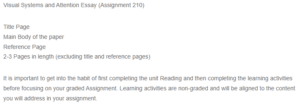Visual Systems and Attention
The Role of the Parietal Lobe in Visual Remapping and Attentional Processing
The parietal eye field is located in the intraparietal sulcus. The human parietal-eye-field is analogous to the lateral intraparietal cortex found in animals (Bisley et al., 2020). Neurons in the lateral intraparietal cortex facilitate visual remapping (Bisley et al., 2020). These neurons coordinate changes to achieve perceptual continuity. Lesions in the lateral intraparietal cortex impede the execution of tasks that are dependent on spatial information (Bisley et al., 2020). Functional magnetic resonance imaging studies demonstrate that saccades facilitate the transmission of visual stimuli between the hemispheres of the lateral intraparietal cortex (Bisley et al., 2020). Low threshold stimulation of the lateral intraparietal cortex causes a change in visual attention, whereas a higher threshold stimulation causes a saccade (Bisley et al., 2020).
Functional magnetic resonance imaging studies have identified the role of the parietal lobe in attentional processes. The temporoparietal junction mediates bottom-up attentional processes (Sheremata et al., 2018). This junction is activated in response to stimuli and during normal activities. Further, the superior parietal lobule mediates top-down attentional processes (Sheremata et al., 2018). The superior parietal lobule elicits transient signals to mediate brief control of attention and shift between attentive states (Sheremata et al., 2018). It does not provide a steady and continuous signal for the maintenance of new attentional processes. Additionally, the superior parietal lobule is mainly involved in spatial shifts in attention (Sheremata et al., 2018). Non-spatial shifts are mediated by the precuneus region (Sheremata et al., 2018).
Similar areas of the parietal cortex can mediate other attentional processes. This can be demonstrated in the presence of a visual task during which both the anterior and inferior sections of the intraparietal sulcus become activated (Sheremata et al., 2018). Conversely, the posterior intraparietal sulcus is activated by the presence of successive distractors (Sheremata et al., 2018).
The Importance of “What” and “Where”
The type and location of stimuli impact visual remapping and attentional processing. Low threshold stimulation of the lateral intraparietal cortex causes a change in visual attention, whereas a higher threshold stimulation causes a saccade (Bisley et al., 2020). Additionally, visual stimuli are transmitted across all hemispheres of the lateral intraparietal cortex (Bisley et al., 2020). In the context of attentional processing, the temporoparietal junction mediates bottom-up attentional processes, whereas the superior parietal lobule mediates top-down attentional processes (Sheremata et al., 2018). Signals that mediate brief control of attention and shifts between attentive states are mediated by the superior parietal lobule (Sheremata et al., 2018). The precuneus region mediates non-spatial signals and those that control and maintain new attentional processes. Successive distractors activate the posterior intraparietal sulcus, whereas the activation of the anterior and inferior intraparietal sulcus is not dependent on distractors (Sheremata et al., 2018).
The Bottleneck Theory
According to Lai et al. (2021), the Bottleneck theory states that people have limited attentional resources to be used at a given time. Consequently, only important information is processed at a specific time (Lai et al., 2021). The Bottleneck theory can be used to explain the occurrence of inattentional blindness and change blindness. Inattentional blindness occurs when individuals fail to detect overt objects (Lai et al., 2021). This is attributed to the fact the individuals had fixated their attention on other objects and hence failed to notice the unexpected overt object (Lai et al., 2021). This suggests that the individuals failed to pay close attention to all happenings in their surroundings. Change blindness refers to the failure to detect the transformation that occurs in a stimulus (Lai et al., 2021). Change blindness and inattentional blindness are consistent with the provisions of the Bottleneck theory. Observers fail to detect overchanges because they have limited attentional resources and can only process the stimulus that is considered important.
References
Bisley, J. W., Mirpour, K., & Alkan, Y. (2020). The functional roles of neural remapping in the cortex. Journal of Vision, 20(9), 1–15. https://doi.org/10.1167/jov.20.9.6
Lai, Q., Li, Y., Zeng, A., Liu, M., Sun, H., & Xu, Q. (2021). Information Bottleneck Approach to Spatial Attention Learning. IJCAI International Joint Conference on Artificial Intelligence, 779–785. https://doi.org/10.24963/ijcai.2021/108
Sheremata, S. L., Somers, D. C., & Shomstein, S. (2018). Visual short-term memory activity in the parietal lobe reflects cognitive processes beyond attentional selection. Journal of Neuroscience, 38(6), 1511–1519. https://doi.org/10.1523/JNEUROSCI.1716-17.2017
ORDER A PLAGIARISM-FREE PAPER HERE
We’ll write everything from scratch
Question 
Visual Systems and Attention Essay (Assignment 210)
Title Page
Main Body of the paper
Reference Page
2-3 Pages in length (excluding title and reference pages)
It is important to get into the habit of first completing the unit Reading and then completing the learning activities before focusing on your graded Assignment. Learning activities are non-graded and will be aligned to the content you will address in your assignment.

Visual Systems and Attention
As you learned from the Reading and Discussion, individual areas of the brain coordinate to create and use attention. There are theories of attention that attempt to explain how these different brain areas communicate to send and receive messages. Here is your opportunity to explain the role of the visual system in attention, focusing on the parietal lobes. This understanding is important to working with children, teens, or adults in mental health and/or addiction treatment.
This assignment measures your understanding of the correlation between visual systems and attention. This week you will complete a 2-3-page expository paper exploring the role of the parietal lobe in visual remapping and attentional processing.
1. Explore the role of the parietal lobe in visual remapping and attentional processing.
2. Discuss the importance of “what” and “where” in this process.
3. Explain how the Bottleneck theory is important in inattentional and change blindness.
Textbook:
Ward, J. (2019). The Student’s Guide to Cognitive Neuroscience (4th Edition). Taylor & Francis. https://purdueuniversityglobal.vitalsource.com/books/9781351035163